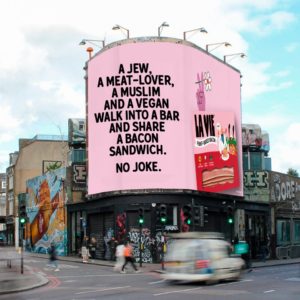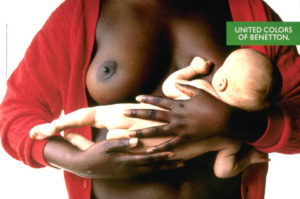When ads get offensive: provocative advertising that simply goes too far
The start of 2023 seems to have been blighted by ads that have done nothing more than cause widespread offence.
There was the Burberry ad which featured a model who had scars on show from a double mastectomy. Part of their ‘B:Mine’ Valentine’s Day campaign it was quickly pulled after it was accused of glamourising the mastectomy procedure.
Then there was La Vie’s attempt to unite religions in its outdoor campaign for its vegan bacon, which was branded as disrespectful, distasteful, and downright racist.

Then there was possibly the most outrageous one so far from Deadhappy who seemed to think using a photo of the serial killer Harold Shipman on their advertising was a good idea. Yes, you read that right.
But the question is are we all being a bit over sensitive or are these ads good examples of when provocative advertising just goes too far?
What’s the real difference between provocative advertising and offensive?
It’s estimated that an average person will encounter between 6,000 and 10,000 ads every single day, so it’s hardly surprising brands are trying to find ways to make their products and services stand out from the crowd.
And using content which shocks people is nothing new. In fact, back in the 1990s there was a discernible rise in ‘shockvertising’, advertising that ‘deliberately startles and offends its audience by violating norms for social values and personal ideas’.
Benetton and their series of controversial ads is a classic example. From a nun kissing a priest to its AIDS ad, their ads have now, by and large, attained cult status, and some of them are even revered for raising important societal issues.


But that’s not to say they didn’t offend some people. The image of a black woman nursing a white baby was meant to show how humanity transcends skin colour, but despite winning awards, it was also seen as perpetuating racism, as in the past black slaves had to breastfeed the children of white owners.

And that highlights the problem: exactly when does provocative advertising become offensive?
If you look at the dictionary definitions for the two words, they are scarily similar:
- Offensive ‘causing someone to feel resentful, upset or annoyed’
- Provocative ‘causing anger or another strong reaction, especially deliberately’
So, given that art in its broadest term is subjective, is it simply down to an individual’s own sensibility?
We would argue not as there are some things that just transcend common decency.
How can using a reference to a mass cult suicide ever be acceptable in advertising and why did Bloomingdale’s think suggesting date rape was good marketing?


And let’s not even mention Hyundai’s ‘Pipe Job’ ad which shows a man attempting suicide by carbon monoxide poisoning in his car.
These aren’t ads which make you stop and think. They are ones which make you sit there with your mouth open in disbelief and wonder ‘why did anyone ever think that was a good idea and how was it approved?’
And that’s because all of these ads have one thing in common. They are exploiting sensitive issues which are likely to cause serious or widespread offence, purely for the purpose of selling their products. And that’s the real difference between provocative advertising and advertising that is downright offensive.
Are there advantages to being provocative?
If you want people to talk about your brand, then yes, there is no doubt that launching a provocative ad campaign is going to work.
Take our Act Against Lungworm ad. We didn’t set out to offend or upset, but we did want people to sit up and take notice. And it worked as Elanco saw their highest results ever.
But the ads were also controversial, as despite using an inclusive range of models, some sections of society took offense. But the point is we didn’t set out to cause widespread offence or use sensitive issues to cause a reaction.
And in recent years other brands have also launched what are considered controversial campaigns which have paid off. Nike’s ads featuring ex-NFL quarterback Colin Kaepernick, who had controversially kneeled during the national anthem for the 2016 NFL season, risked alienating their customer base. Instead, it resulted in a 31% increase in sales.
And there is this 2015 Super Bowl ad from Carl’s Junior. Controversial but a massive success, but then that’s hardly surprising when you have a CEO who says ‘If people don’t complain, I go to the head of marketing and say, “What’s wrong with your ads?”’
But neither of these examples exploit sensitive issues or set out to denigrate people unfairly. Yes, they are definitely provocative, and some people would have found them offensive, but they didn’t cause serious offence and still remain on the right side of common decency.
And that’s the key. If you do want to be controversial you need to step carefully as while PT Barnum may have said “Bad press is better than no press” get it wrong and it will have a negative impact on your brand.
Look at Burberry. By failing to issue a statement about why they pulled the ad, they are now being accused of profiting from images of trans people as they haven’t stood by their decision to show the ad in the first place. At least Deadhappy have had the courtesy to issue an apology!
So where is the line?
And this is the million-dollar question – how far can you go and how far should you go?
Exploiting sensitive issues to sell a product is a definite no-no, and we would also argue it’s best to stay away from politics, religion, race, disability and sex. Yes, sex does sell, but make sure it doesn’t embody gender stereotypes, and isn’t indecent or offensive.
But we also need to remember that times have and will continue to change. What we found acceptable years ago, wouldn’t be acceptable today. The ‘Hello Boys’ Wonderbra ad was considered the scourge of the feminist movement when it first came out, so would it be allowed today?

Probably not especially since its repositioning in 2018 to ‘Hello me!’ aimed at female self-empowerment was slammed as being the ‘same nonsense, different era’.
Doing your research and being aware of what’s going on in society, how our culture is changing, and differing views and opinions is more important than ever, especially if you want to go down the provocative advertising route.
Above all brands need to be sensitive to other people’s feelings and perceptions, so while something might seem tongue-in-cheek or just a little bit risqué in the confines of the office, think about how’s it going to be received in the wider world. If it’s likely to cause serious or widespread offence rather than a few disgruntled objections, then it’s probably best to bin the idea.
And a final thought, don’t use serial killers in your advertising!
